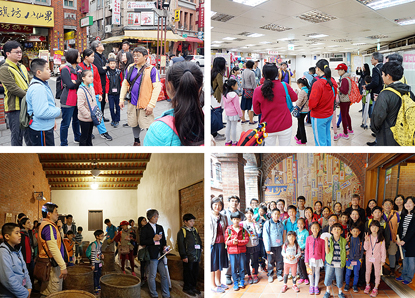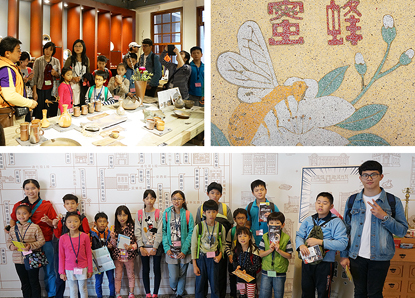Sketch of Archilife Study Tour, March 2018
|
2018年3月份見識之旅縮影  3月份見識之旅活動,於2018年3月17日由呂明澐小姐帶領26位祐生見習生及家長們,進行大稻埕百年風華暨茶香歲月文化之旅。活動開始之初,領隊呂明澐小姐提醒本次活動注意事項及觀察重點,先行建立見習生的背景知識。 3月份見識之旅活動,於2018年3月17日由呂明澐小姐帶領26位祐生見習生及家長們,進行大稻埕百年風華暨茶香歲月文化之旅。活動開始之初,領隊呂明澐小姐提醒本次活動注意事項及觀察重點,先行建立見習生的背景知識。For the study tour of March 17, 2018, Ms. Lu Ming-yun led 26 ARF interns and their parents on a tour to Dadaocheng to witness its century-old historical charm and tea culture. At the start of the day's activities, team leader Ms. Lu Ming-yun reminded everyone about things to note and what to observe, and provided the interns some general background knowledge.  本次行程以大稻埕地區為參訪主軸,由高傳棋先生擔任導覽老師。大稻埕為清末台北最繁華的物資集散中心,主要以茶葉、布料及南北貨貿易為主,後因淡水河港受戰爭破壞,茶葉出口量銳減,且市中心向東轉移而逐漸沒落。行程一開始,高老師帶領眾人參訪霞海城隍廟,說明城隍廟的由來及供奉的神祇,其中奉祀於偏殿的義勇公,係感念漳泉械鬥之時,為保護城隍神像奮勇捐軀的三十八位壯士。離開城隍廟後,來到迪化街南段,高老師講述早期店屋的特色,即前店後屋、深度狹長,兼具生意買賣與生活機能,且為適應多雨氣候皆設有騎樓,眾人亦進入觀察內部建築構造。接著步行至新芳春行,高老師首先介紹茶行歷史及空間利用,並針對昔日大稻埕茶業發展與茶葉烘焙流程做詳細解說,最後見習生們進行茶包的摺紙包裝體驗,認識今昔茶裝方式的差異。 本次行程以大稻埕地區為參訪主軸,由高傳棋先生擔任導覽老師。大稻埕為清末台北最繁華的物資集散中心,主要以茶葉、布料及南北貨貿易為主,後因淡水河港受戰爭破壞,茶葉出口量銳減,且市中心向東轉移而逐漸沒落。行程一開始,高老師帶領眾人參訪霞海城隍廟,說明城隍廟的由來及供奉的神祇,其中奉祀於偏殿的義勇公,係感念漳泉械鬥之時,為保護城隍神像奮勇捐軀的三十八位壯士。離開城隍廟後,來到迪化街南段,高老師講述早期店屋的特色,即前店後屋、深度狹長,兼具生意買賣與生活機能,且為適應多雨氣候皆設有騎樓,眾人亦進入觀察內部建築構造。接著步行至新芳春行,高老師首先介紹茶行歷史及空間利用,並針對昔日大稻埕茶業發展與茶葉烘焙流程做詳細解說,最後見習生們進行茶包的摺紙包裝體驗,認識今昔茶裝方式的差異。Focusing on the Dadaocheng area, the tour was guided by Mr. Gao Chuan-chi. At the end of the Qing Dynasty, Dadaocheng was the busiest distribution center in Taipei, where tea leaves, textiles and dried goods were being traded. With the destruction of the Tamsui Port during the war, a sharp fall in export of tea leaves, and the relocation of the city center to the east side, Dadaocheng began to see a decline. At the start of the tour, Mr. Gao led everyone to Xiahai City God Temple where he explained the origin of the temple and deities that are being worshipped there. In particular, he pointed out the statues of "Brave Guards" that are worshipped in a side hall. The Brave Guards represent 38 brave people who sacrificed themselves to protect the City God statue during the armed conflict between Zhangzhou and Quanzhou. Leaving the temple, the group moved on to the southern section of Dihua Street. Mr. Gao explained that shophouses built in the early days were deep and narrow with the shop in the front and living quarters in the back, allowing for both business dealing and everyday life functions. These shophouses also have arcade designed for the rainy weather. Everyone went in to observe the interior architecture of these shophouses before walking over to Sin Hong Choon. Mr. Gao began by introducing the history of Sin Hong Choon and how space is being utilized. He also described the development of the tea industry in Dadaocheng and the steps involved in roasting tea leaves. Finally, the interns experienced folding paper packaging for tea leaves, and learned the differences between packaging of the past and present.  中午至稻舍用餐,其位於一棟百年紅磚建築中,前身為米行,近年透過政府推動的「都市再生前進基地」計劃,蛻變成以推廣台灣米食文化為主的特色餐廳。飯後,眾人進一步探訪老屋整體空間,了解老宅故事。隨後進行南北貨導覽,高老師解釋迪化街成為集散地之原因,並帶領眾人參觀當地的蒜頭批發、專賣鍋具器皿等店家。行程最後,至迪化207博物館參訪,前身是中藥鋪,目前做為以台灣人文歷史為展覽主軸的藝文空間。因位於三角窗地帶,建築呈圓弧狀,館中保留最具特色的磨石子工藝,經由高老師解說,見習生們對磨石子技法留下初步印象,並學習欣賞早期建築之美。至此,本日活動已近尾聲,大家一起合照留念後各自返家,並期待於下次見識之旅再相見。 中午至稻舍用餐,其位於一棟百年紅磚建築中,前身為米行,近年透過政府推動的「都市再生前進基地」計劃,蛻變成以推廣台灣米食文化為主的特色餐廳。飯後,眾人進一步探訪老屋整體空間,了解老宅故事。隨後進行南北貨導覽,高老師解釋迪化街成為集散地之原因,並帶領眾人參觀當地的蒜頭批發、專賣鍋具器皿等店家。行程最後,至迪化207博物館參訪,前身是中藥鋪,目前做為以台灣人文歷史為展覽主軸的藝文空間。因位於三角窗地帶,建築呈圓弧狀,館中保留最具特色的磨石子工藝,經由高老師解說,見習生們對磨石子技法留下初步印象,並學習欣賞早期建築之美。至此,本日活動已近尾聲,大家一起合照留念後各自返家,並期待於下次見識之旅再相見。Lunch was eaten at Rice & Shine URS329. Located within a century-old brick building, the restaurant was formerly a rice wholesale shop. In recent years, through the government's "Urban Regeneration Station" initiative, it has transformed into a restaurant specializing in promotion of rice culture in Taiwan. After lunch, everyone went on a tour of the old house and learned about its stories. What followed was a guided tour of dried goods. Mr. Gao explained the reason why Dihua Street has become a distribution hub for dried goods, and led everyone to various shops, including one that sold wholesale garlic and one that sold kitchen utensils. The tour ended with a visit to Museum 207, which was formerly a traditional Chinese medicine shop and is now an exhibition space that mainly showcases Taiwan's culture and history. Due to its corner location, the building has a circular arc structure and features unique terrazzo craftsmanship. After Mr. Gao's explanation, the interns formed an initial impression of terrazzo techniques and learned to appreciate the beauty of early architecture. At this point, the day's itinerary came to an end. Everyone returned to home after taking a group photo and looked forward to the next study tour. |

